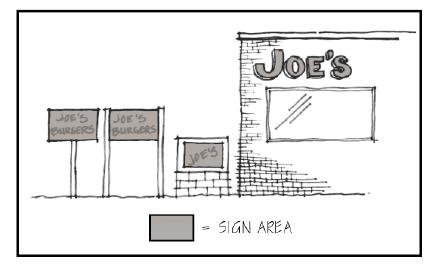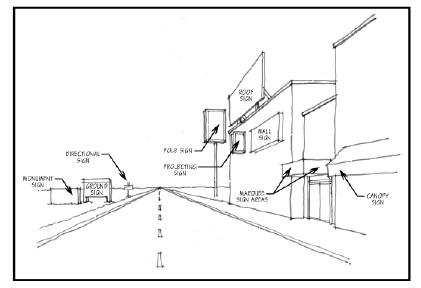The following definitions shall be used for terms contained in this chapter that are not otherwise defined in the Denison Code of Ordinances or in this Zoning Ordinance.
1. Abandoned Sign: A sign, including sign face and supporting structure, which refers to a discontinued business, profession, commodity, service, or other activity or use formerly occupying the site; or which contains no sign copy on all sign faces for a continuous period of six months.
2. Attached Sign: A sign that is structurally connected to a building or depends upon that building for support.
3. Auxiliary Design Elements: Terms that describe secondary characteristics of a sign, including its method of illumination and other features within the bounds of its basic shape.
4. Awning and Awning Sign: A temporary or movable shelter supported entirely from the exterior wall of a building and composed of non-rigid materials, except for a supporting framework. An awning sign is a message printed on such a shelter.
5. Banner: Material with a printed message or graphic secured or mounted from a structure in such a way as to allow wind movement.
6. Building Marker: An historic or commemorative plaque, or a building name or cornerstone carved into a masonry surface.
7. Business Center Identification Sign: A sign that identifies a building or group of commercial buildings in single ownership or control, sharing parking and access.
8. Canopy (or arcade) Sign: A sign that is attached or made an integral part of a canopy.
9. Clearance: The distance from the bottom of a sign face elevated above grade and the grade below.
10. Detached Sign: A sign that is self-supporting and structurally independent from any building.
11. Directional Sign: A sign that serves only to designate the location or direction of any area or place.
12. Double-Faced Sign: A sign consisting of no more than two parallel or near parallel faces supported by a single structure. The angle created by the two faces of a double-faced sign shall not exceed 15 degrees.
13. Electronic Information Signs: Signs which use an array of electrically illuminated lights, generally controlled by a computer or other electronic programming device, to display information or supporting graphics. Information may include news, events, or information about businesses or attractions. Signs whose information is limited to time and temperature are not considered electronic information signs.
14. Flag Sign: Signs that are emblazoned on a flag and are intended to be displayed in a free-flowing manner. Flags of the United States, the State of Iowa, and any institution in the Iowa university system shall not be considered flag signs for the purpose of this chapter.
15. Flashing Sign: A sign that has a lighting source or lighting element that periodically illuminates or is not maintained stationary or constant in intensity and/or color at all times when the sign is in use, usually in a manner as to draw the attention of the viewer. This definition specifically excludes electronic information signs.
16. Frontage: The length of a property line of any one premises abutting and parallel to a public street, private way, or court.
17. Ground Sign: A detached on-premise sign built on a freestanding frame, mast, or pole(s) with a clearance no greater than 3 feet.
18. Illumination: Lighting sources installed for the primary purpose of lighting a specific sign or group of signs.
19. Marquee: A permanent roofed structure attached to and supported by a building and extending over public right-of-way.

20. Maximum Permitted Sign Area: The maximum permitted combined area of all signs allowed on a specific property.
21. Monument Sign: An on-premise freestanding sign with the appearance of a solid base.
22. Moving Sign: A sign that conveys its message through rotating, changing, or animated elements.
23. Nonconforming Sign: A sign that was legally erected prior to the adoption of this chapter but which violates the regulations of this chapter.
24. Obsolete Signs: Signs that identify a business or occupant that is no longer in operation at the premises.
25. Outdoor Advertising Signs (Billboards): A panel for the display of information relating to a business, product, event, or other subject of advertising or publicity. Outdoor advertising signs may advertise on-premise or off-premise businesses or products, but are not included in the definition of premise identification signs. New outdoor advertising signs are not permitted within the city limits of the City of Denison.
26. Pole Sign: An on-premise sign built on a freestanding frame, mast, or pole(s) with a clearance greater than 3 feet.
27. Portable Sign: Any sign supported by frames or posts rigidly attached to bases not permanently attached to the ground or a building and capable of being moved from place to place.
28. Premise Identification Sign: A sign which pertains to the use of a premises and which contains information about the owner or operator of that use; the type of business being conducted or the principal brand name of a commodity sold on the premises; and other information relative to the conduct of the use.
29. Premises: A tract of one or more lots or sites that are contiguous and under common ownership or control.
30. Projecting Signs: A sign other than a wall sign that is attached to and projects from a building face.
31. Residential Sign: A small detached or attached sign located on a residential premise, conveying a message communicated by the owner of the property.

32. Roof Sign: Any sign or part of sign erected upon, against, or directly above a roof or on top of or above the parapet or cornice of a building.
A. Integral Roof Sign: A roof sign positioned between an eave line and the peak or highest point on a roof, substantially parallel to the face of a building.
B. Above-peak Roof Sign: A roof sign positioned above the peak of a roof or above a parapet or cornice.
33. Sign: A symbolic, visual device fixed upon a building, vehicle, structure, or parcel of land which is intended to convey information about a product, business, activity, place, person, institution, candidate, or political idea.
34. Sign Type: A functional description of the use of an individual sign. Includes owner identification, advertising, directional, electronic message, and temporary.
35. Street Facade: Any separate external face of a building, including parapet walls and omitted wall lines, oriented to and facing a public street, private way, or court. Separate faces oriented in the same direction or within 45 degrees of one another are considered part of the same street facade.
36. Temporary Signs: Any sign designed or fabricated of materials that advertise or communicate messages that change frequently or that become outdated; are made of materials of relatively low durability; are intended to be removed or replaced within a period of six months or less; or are portable. Temporary signs generally fall into two categories: temporary civic signs and temporary commercial signs.
37. Wall Sign: A sign attached to and parallel with the side of a building.
38. Window Sign: A sign painted on or installed inside a window for the purpose of viewing from outside the premises.
39. Zone Lot: A parcel of land in single ownership that is large enough to meet the minimum zoning requirements of its zoning district and can provide such yards and other open spaces that are required by the site development regulations.